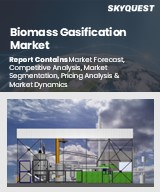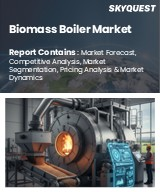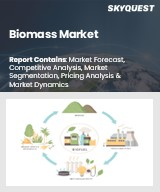
|
시장보고서
상품코드
1438078
세계의 바이오매스 펠릿 시장 전망(-2030년) : 공급원별, 용도별, 지역별 분석Biomass Pellets Market Forecasts to 2030 - Global Analysis By Source (Wood Sawdust, Virgin Lumber and Other Sources), Application (Power Generation, Industrial Heating and Other Applications), and By Geography |
||||||
Stratistics MRC에 따르면, 세계 바이오매스 펠릿 시장은 2023년 69억 9,000만 달러로 평가되었고, 예측 기간 동안 연평균 7.50% 성장하여 2030년에는 115억 9,000만 달러에 달할 것으로 예상됩니다.
바이오매스 펠릿은 목재, 농업 잔재 및 기타 식물성 유기물에서 추출한 재생 가능 에너지의 한 형태입니다. 이러한 재료는 압축되어 직경이 보통 6-10mm인 작은 고밀도 펠릿으로 만들어집니다. 바이오매스 펠릿은 기존의 화석 연료를 대체할 수 있는 지속 가능한 대체 에너지로서 보다 깨끗하고 환경 친화적인 대안을 제공합니다.
India Brand Equity Foundation(IBEF)에 따르면, 인도는 2028년까지 재생에너지 부문에 5,000억 달러 상당의 투자가 이루어질 것으로 예상됩니다. 또한 국제에너지기구(IEA)에 따르면 2022년까지 전 세계 태양광 발전량은 162GW에 달할 것으로 예상됩니다.
에너지 안보
바이오매스 펠릿 시장의 에너지 안보 원동력은 유한하고 지정학적 영향을 받기 쉬운 화석연료에 대한 의존도를 줄이고자 하는 열망에서 비롯됩니다. 목재, 농업 잔재물 등 유기물을 원료로 하는 바이오매스 펠릿은 지속 가능하고 재생 가능한 대체 에너지를 제공합니다. 각국은 바이오매스 펠릿을 통해 에너지 믹스를 다양화하고, 공급 위험을 줄이고, 보다 견고하고 분산된 에너지 인프라를 촉진하여 에너지 안보를 강화하고자 합니다. 바이오매스 펠릿으로의 전환은 신뢰할 수 있는 현지 생산 에너지 공급을 보장하고, 외부의 혼란에 대한 취약성을 줄이고, 장기적인 에너지 자립을 촉진하는 데 도움이 될 수 있습니다.
원료의 가용성 및 비용
원료의 가용성과 비용은 바이오매스 펠릿 시장에 영향을 미치는 중요한 요소입니다. 농업 잔재, 목재 찌꺼기, 에너지 작물 등 원료의 가용성은 생산량에 직접적인 영향을 미칩니다. 공급 가능한 원료가 제한적일 경우 공급망에 혼란을 초래하여 펠릿 제조업체에 영향을 미칠 수 있습니다. 또한 계절적 변동, 운송비, 자원 확보 경쟁에 영향을 받는 원료 비용의 변동은 시장의 불확실성을 가중시키는 요인으로 작용합니다. 바이오매스 펠릿에 대한 수요와 지속 가능한 원료 조달의 균형을 맞추는 것이 시장 안정에 필수적입니다.
기존 인프라와의 통합
기존 인프라와의 통합은 시장에 큰 기회를 제공합니다. 바이오매스 펠릿은 기존 발전소, 산업 시설 및 주택 난방 시스템에서 기존 화석 연료를 직접 대체할 수 있기 때문에 비교적 원활하게 전환할 수 있습니다. 이러한 호환성을 통해 기업은 현재 인프라를 활용할 수 있어 비용이 많이 드는 개조 작업의 필요성을 최소화할 수 있습니다. 또한, 바이오매스 펠릿은 기존 발전소에서 석탄과 혼합 연소할 수 있어 재생에너지 도입에 대한 유연하고 과도기적인 접근 방식을 제공합니다.
날씨와 기후 조건
기온, 강수량, 기상 이변은 목재, 농업 잔재물 등 바이오매스 원료의 가용성과 품질에 영향을 미칠 수 있습니다. 예측할 수 없는 날씨는 생산에 혼란을 초래하고 바이오매스 펠릿 가격의 변동으로 이어질 수 있습니다. 기후 변화는 바이오매스 자원의 지리적 분포를 변화시켜 전체 산업의 지속가능성과 신뢰성에 영향을 미칠 수 있습니다. 또한 악천후는 운송 및 물류에도 영향을 미쳐 바이오매스 펠릿 시장의 회복력을 더욱 어렵게 만들 수 있습니다.
COVID-19의 영향 :
코로나19 사태는 시장에 다양한 영향을 미쳤습니다. 한편으로는 재생 가능 에너지에 대한 관심이 높아지면서 기존 연료를 대체할 수 있는 지속 가능한 대체 에너지로 바이오매스 펠릿에 대한 수요가 증가하고 있습니다. 그러나 팬데믹으로 인한 공급망 혼란, 노동력 부족, 경제 불확실성이 생산과 유통을 방해하고 있습니다. 또한, 에너지 가격 변동과 팬데믹에 대한 정부의 우선순위가 바이오매스 분야 투자 패턴에 영향을 미치고 있습니다. 전반적으로, 청정 에너지에 대한 관심이 높아지면서 시장은 회복력을 보이고 있습니다.
농업 잔여물 부문은 예측 기간 동안 가장 큰 시장으로 성장할 것으로 예상됩니다.
농업 잔류물 부문은 지속 가능한 폐기물 활용과 재생 가능 에너지 생산이라는 두 가지 장점으로 인해 시장에서 큰 성장세를 보이고 있습니다. 환경 문제에 대한 인식이 높아지고 청정 에너지원에 대한 필요성이 증가함에 따라 작물 찌꺼기, 짚, 볏짚, 왕겨와 같은 농업 잔재물에서 추출한 바이오매스 펠릿에 대한 수요가 급증하고 있습니다. 이러한 성장은 재생 가능한 에너지원으로 바이오매스 사용을 촉진하고 농부들이 농업 폐기물을 지속적으로 관리할 수 있도록 인센티브를 제공하는 정부의 이니셔티브에 힘입어 더욱 가속화되고 있습니다.
예측 기간 동안 발전 분야가 가장 높은 CAGR을 보일 것으로 예상됩니다.
바이오매스가 지속 가능한 재생에너지로 인식되면서 바이오매스 발전 분야는 강력한 성장세를 보이고 있습니다. 목재, 농업 잔재, 폐기물 등 유기물에서 추출한 바이오매스 펠릿은 기존 화석연료를 대체할 수 있는 청정 대체 에너지를 제공합니다. 친환경 에너지 솔루션을 장려하는 정부의 인센티브와 환경 규제는 발전용 바이오매스 펠릿에 대한 수요를 더욱 증가시키고 있습니다. 펠릿의 높은 에너지 밀도, 운송의 용이성, 효율적인 연소 등이 발전 사업자들 사이에서 높은 인기를 얻고 있습니다.
가장 큰 점유율을 차지하는 지역
북미는 지속 가능한 에너지원에 대한 인식이 높아지고 이산화탄소 배출량을 줄이기 위한 노력으로 인해 시장이 크게 성장하고 있습니다. 재생 가능한 대체 에너지에 대한 수요 증가와 청정 에너지 솔루션에 대한 정부 이니셔티브에 힘입어 바이오매스 펠릿 생산에 대한 투자가 증가하고 있습니다. 목재 찌꺼기, 농산부산물 등 바이오매스 원료의 풍부한 가용성 또한 시장 확대를 더욱 촉진하고 있습니다.
CAGR이 가장 높은 지역 :
아시아태평양은 재생 가능한 에너지원과 지속 가능한 관행에 대한 관심이 높아짐에 따라 시장이 크게 성장하고 있습니다. 이 지역의 각국 정부는 바이오매스 에너지 활성화를 위한 지원 정책과 인센티브 정책을 시행하고 있으며, 시장 확대에 유리한 환경을 조성하고 있습니다. 이산화탄소 배출량 감소, 화석연료 의존도 감소 등 바이오매스 펠릿의 환경적 이점에 대한 인식이 높아짐에 따라 수요를 촉진하고 있습니다.
무료 커스터마이징 서비스
이 보고서를 구독하는 고객은 다음과 같은 무료 맞춤화 옵션 중 하나를 사용할 수 있습니다.
- 기업 프로파일
- 추가 시장 기업의 종합적인 프로파일링(최대 3개사까지)
- 주요 기업의 SWOT 분석(최대 3개사)
- 지역 세분화
- 고객의 관심에 따른 주요 국가별 시장 추정치, 예측, CAGR(주: 타당성 확인에 따라 다름)
- 경쟁사 벤치마킹
- 제품 포트폴리오, 지리적 입지, 전략적 제휴를 기반으로 한 주요 기업 벤치마킹
목차
제1장 주요 요약
제2장 서문
- 개요
- 이해관계자
- 조사 범위
- 조사 방법
- 데이터 마이닝
- 데이터 분석
- 데이터 검증
- 조사 접근
- 조사 소스
- 1차 조사 소스
- 2차 조사 소스
- 전제조건
제3장 시장 동향 분석
- 성장 촉진요인
- 성장 억제요인
- 기회
- 위협
- 용도 분석
- 신흥 시장
- 신형 코로나바이러스(COVID-19)의 영향
제4장 Porter의 Five Forces 분석
- 공급 기업의 교섭력
- 바이어의 교섭력
- 대체품의 위협
- 신규 진출업체의 위협
- 경쟁사간 경쟁 관계
제5장 세계의 바이오매스 펠릿 시장 : 공급원별
- 목재 톱밥
- 버진 목재
- 산업 폐기물 및 제품별
- 작물 줄기
- 짚 재료
- 왕겨
- 커피 껍질
- 알팔파 스트로
- 기타 산업 폐기물 및 제품별
- 농업 잔류물
- 제재소 잔여물
- 가지
- 나무껍질
- 나뭇잎
- 기타 농업 잔류물
- 식품 폐기물
- 기타 공급원
제6장 세계의 바이오매스 펠릿 시장 : 용도별
- 발전
- 발전소
- 풍력 터빈
- 기타 발전
- 산업용 난방
- 상업용 및 가정용 난방
- 펠릿 스토브
- 자립형 스토브
- 펠릿 보일러
- 동물 침구
- 기타 용도
제7장 세계의 바이오매스 펠릿 시장 : 지역별
- 북미
- 미국
- 캐나다
- 멕시코
- 유럽
- 독일
- 영국
- 이탈리아
- 프랑스
- 스페인
- 기타 유럽
- 아시아태평양
- 일본
- 중국
- 인도
- 호주
- 뉴질랜드
- 한국
- 기타 아시아태평양
- 남미
- 아르헨티나
- 브라질
- 칠레
- 기타 남미
- 중동 및 아프리카
- 사우디아라비아
- 아랍에미리트(UAE)
- 카타르
- 남아프리카공화국
- 기타 중동 및 아프리카
제8장 주요 발전
- 계약/파트너십/협업/합작투자(JV)
- 인수와 합병
- 신제품 발매
- 사업 확대
- 기타 주요 전략
제9장 기업 개요
- ANVIETPHAT
- Buhler AG
- Drax Group Plc
- Energex Corporation
- Enviva
- Forest Energy Corporation
- International WoodFuels LLC
- New England Wood Pellet
- Pinnacle Renewable Energy Inc.
- Sumitomo Corporation
LSH 24.04.11
According to Stratistics MRC, the Global Biomass Pellets Market is accounted for $6.99 billion in 2023 and is expected to reach $11.59 billion by 2030 growing at a CAGR of 7.50% during the forecast period. Biomass pellets are a form of renewable energy derived from organic materials such as wood, agricultural residues, and other plant-based sources. These materials are compressed into small, dense pellets, typically with diameters ranging from 6 to 10 millimeters. Biomass pellets serve as a sustainable alternative to traditional fossil fuels, offering a cleaner and more environmentally friendly energy option.
According to the India Brand Equity Foundation (IBEF), India is expected to invest worth US$ 500 billion in the renewable energy sector by 2028. In addition, according to the International Energy Agency (IEA), the global solar photovoltaics development is forecast to reach 162 GW by 2022.
Market Dynamics:
Driver:
Energy security
The energy security driver of the biomass pellet market stems from the desire to reduce dependence on finite and geopolitically sensitive fossil fuel sources. Biomass pellets, derived from organic materials like wood or agricultural residues, offer a sustainable and renewable energy alternative. By utilizing biomass pellets, countries aim to enhance their energy security by diversifying their energy mix, mitigating supply risks, and promoting a more resilient and decentralized energy infrastructure. This shift towards biomass pellets helps ensure a reliable and locally sourced energy supply, reducing vulnerability to external disruptions and fostering long-term energy independence.
Restraint:
Feedstock availability and cost
Feedstock availability and cost are critical factors influencing the biomass pellet market. The accessibility of raw materials such as agricultural residues, wood waste, and energy crops, directly impact production volumes. Limited feedstock availability can lead to supply chain disruptions, affecting pellet manufacturers. Additionally, fluctuations in feedstock costs, influenced by seasonal variations, transportation expenses, and competition for resources, contribute to market uncertainties. Balancing the demand for biomass pellets with sustainable feedstock sourcing practices is essential for market stability.
Opportunity:
Integration with existing infrastructure
Integration with existing infrastructure presents a significant opportunity in the market. As biomass pellets can be used as a direct substitute for traditional fossil fuels in existing power plants, industrial facilities, and residential heating systems, the transition is relatively seamless. This compatibility allows businesses to leverage their current infrastructure, minimizing the need for costly modifications. Additionally, biomass pellets can be co-fired with coal in existing power plants, offering a flexible and transitional approach toward renewable energy adoption.
Threat:
Weather and climate conditions
Fluctuations in temperature, precipitation patterns, and extreme weather events can impact the availability and quality of biomass feedstocks such as wood and agricultural residues. Unpredictable weather can disrupt the production, leading to fluctuations in biomass pellet prices. Climate change may alter the geographical distribution of biomass resources, affecting the overall sustainability and reliability of the industry. Additionally, adverse weather conditions can also impact transportation and logistics, further challenging the biomass pellet market's resilience.
Covid-19 Impact:
The COVID-19 pandemic has had a mixed impact on the market. On one hand, increased focus on renewable energy sources has driven demand for biomass pellets as a sustainable alternative to traditional fuels. However, supply chain disruptions, labor shortages, and economic uncertainties during the pandemic have hampered production and distribution. Additionally, fluctuating energy prices and government priorities in response to the pandemic have influenced investment patterns in the biomass sector. Overall, while the market shows resilience due to the growing emphasis on clean energy.
The agriculture residue segment is expected to be the largest during the forecast period
The agriculture residue segment is experiencing significant growth in the market due to its dual advantage of sustainable waste utilization and renewable energy production. As awareness of environmental issues and the need for cleaner energy sources rises, the demand for biomass pellets derived from agricultural residues such as crop residues, straw, and husks has surged. This growth is further propelled by government initiatives promoting the use of biomass as a renewable energy source and providing incentives for farmers to manage agricultural waste sustainably.
The power generation segment is expected to have the highest CAGR during the forecast period
The power generation segment in the market is experiencing robust growth due to the increasing recognition of biomass as a sustainable and renewable energy source. Biomass pellets, derived from organic materials such as wood, agricultural residues, and waste, offer a cleaner alternative to traditional fossil fuels. Government incentives and environmental regulations promoting green energy solutions have further fuelled the demand for biomass pellets in power generation. The pellets' high energy density, ease of transport, and efficient combustion contribute to their popularity among power producers.
Region with largest share:
The North American region has witnessed substantial growth in the market due to a rising awareness of sustainable energy sources and a commitment to reducing carbon emissions. Increased demand for renewable energy alternatives has driven investments in biomass pellet production, supported by government initiatives promoting cleaner energy solutions. The abundant availability of biomass feedstock, such as wood residues and agricultural by-products, has further propelled market expansion.
Region with highest CAGR:
The Asia-Pacific region has experienced significant growth in the market, driven by the increasing emphasis on renewable energy sources and sustainable practices. Governments across the region have implemented supportive policies and incentives to promote biomass energy, fostering a favorable environment for market expansion. Rising awareness about the environmental benefits of biomass pellets, such as reduced carbon emissions and dependence on fossil fuels, has fueled demand.
Key players in the market
Some of the key players in Biomass Pellets market include ANVIETPHAT, Buhler AG, Drax Group Plc, Energex Corporation, Enviva, Forest Energy Corporation, International Wood Fuels LLC, New England Wood Pellet, Pinnacle Renewable Energy Inc. and Sumitomo Corporation
Key Developments:
In November 2023, Swiss technology group Buhler has unveiled its new food innovation hub in Uzwil, Switzerland, opening up four new Application & Training Centers (ATCs). The company's existing ATCs, such as its Extrusion Application Center, will complement the new facilities, which aim to connect the entire value chain and enable a circular economy approach to food production.
In November 2023, Drax Group, has partnered with Patch, a climate technology company that is building digital infrastructure for the carbon market of the future. Patch's software helps voluntary carbon market participants buy, sell, and manage credits. With the Patch Radius software solution, Drax customers will be able to seamlessly purchase from a number of portfolios of carbon credits, including those from BECCS by Drax.
Sources Covered:
- Wood Sawdust
- Virgin Lumber
- Industrial Waste & Co-product
- Agriculture Residue
- Food Waste
- Other Sources
Applications Covered:
- Power Generation
- Industrial Heating
- Commercial and Domestic Heating
- Pellet Stove
- Free-Standing Stoves
- Pellet Boilers
- Animal Bedding
- Other Applications
Regions Covered:
- North America
- US
- Canada
- Mexico
- Europe
- Germany
- UK
- Italy
- France
- Spain
- Rest of Europe
- Asia Pacific
- Japan
- China
- India
- Australia
- New Zealand
- South Korea
- Rest of Asia Pacific
- South America
- Argentina
- Brazil
- Chile
- Rest of South America
- Middle East & Africa
- Saudi Arabia
- UAE
- Qatar
- South Africa
- Rest of Middle East & Africa
What our report offers:
- Market share assessments for the regional and country-level segments
- Strategic recommendations for the new entrants
- Covers Market data for the years 2021, 2022, 2023, 2026, and 2030
- Market Trends (Drivers, Constraints, Opportunities, Threats, Challenges, Investment Opportunities, and recommendations)
- Strategic recommendations in key business segments based on the market estimations
- Competitive landscaping mapping the key common trends
- Company profiling with detailed strategies, financials, and recent developments
- Supply chain trends mapping the latest technological advancements
Free Customization Offerings:
All the customers of this report will be entitled to receive one of the following free customization options:
- Company Profiling
- Comprehensive profiling of additional market players (up to 3)
- SWOT Analysis of key players (up to 3)
- Regional Segmentation
- Market estimations, Forecasts and CAGR of any prominent country as per the client's interest (Note: Depends on feasibility check)
- Competitive Benchmarking
- Benchmarking of key players based on product portfolio, geographical presence, and strategic alliances
Table of Contents
1 Executive Summary
2 Preface
- 2.1 Abstract
- 2.2 Stake Holders
- 2.3 Research Scope
- 2.4 Research Methodology
- 2.4.1 Data Mining
- 2.4.2 Data Analysis
- 2.4.3 Data Validation
- 2.4.4 Research Approach
- 2.5 Research Sources
- 2.5.1 Primary Research Sources
- 2.5.2 Secondary Research Sources
- 2.5.3 Assumptions
3 Market Trend Analysis
- 3.1 Introduction
- 3.2 Drivers
- 3.3 Restraints
- 3.4 Opportunities
- 3.5 Threats
- 3.6 Application Analysis
- 3.7 Emerging Markets
- 3.8 Impact of Covid-19
4 Porters Five Force Analysis
- 4.1 Bargaining power of suppliers
- 4.2 Bargaining power of buyers
- 4.3 Threat of substitutes
- 4.4 Threat of new entrants
- 4.5 Competitive rivalry
5 Global Biomass Pellets Market, By Source
- 5.1 Introduction
- 5.2 Wood Sawdust
- 5.3 Virgin Lumber
- 5.4 Industrial Waste & Co-product
- 5.4.1 Crop Stalk
- 5.4.2 Straw Material
- 5.4.3 Rice Husk
- 5.4.4 Coffee Husk
- 5.4.5 Alfalfa Straw
- 5.4.6 Other Industrial Wastes & Co-products
- 5.5 Agriculture Residue
- 5.5.1 Sawmill Residue
- 5.5.2 Branches
- 5.5.3 Bark
- 5.5.4 Leaves
- 5.5.5 Other Agriculture Residues
- 5.6 Food Waste
- 5.7 Other Sources
6 Global Biomass Pellets Market, By Application
- 6.1 Introduction
- 6.2 Power Generation
- 6.2.1 Power Plant
- 6.2.2 Wind & Turbine
- 6.2.3 Other Power Generations
- 6.3 Industrial Heating
- 6.4 Commercial and Domestic Heating
- 6.5 Pellet Stove
- 6.6 Free-Standing Stoves
- 6.7 Pellet Boilers
- 6.8 Animal Bedding
- 6.9 Other Applications
7 Global Biomass Pellets Market, By Geography
- 7.1 Introduction
- 7.2 North America
- 7.2.1 US
- 7.2.2 Canada
- 7.2.3 Mexico
- 7.3 Europe
- 7.3.1 Germany
- 7.3.2 UK
- 7.3.3 Italy
- 7.3.4 France
- 7.3.5 Spain
- 7.3.6 Rest of Europe
- 7.4 Asia Pacific
- 7.4.1 Japan
- 7.4.2 China
- 7.4.3 India
- 7.4.4 Australia
- 7.4.5 New Zealand
- 7.4.6 South Korea
- 7.4.7 Rest of Asia Pacific
- 7.5 South America
- 7.5.1 Argentina
- 7.5.2 Brazil
- 7.5.3 Chile
- 7.5.4 Rest of South America
- 7.6 Middle East & Africa
- 7.6.1 Saudi Arabia
- 7.6.2 UAE
- 7.6.3 Qatar
- 7.6.4 South Africa
- 7.6.5 Rest of Middle East & Africa
8 Key Developments
- 8.1 Agreements, Partnerships, Collaborations and Joint Ventures
- 8.2 Acquisitions & Mergers
- 8.3 New Product Launch
- 8.4 Expansions
- 8.5 Other Key Strategies
9 Company Profiling
- 9.1 ANVIETPHAT
- 9.2 Buhler AG
- 9.3 Drax Group Plc
- 9.4 Energex Corporation
- 9.5 Enviva
- 9.6 Forest Energy Corporation
- 9.7 International WoodFuels LLC
- 9.8 New England Wood Pellet
- 9.9 Pinnacle Renewable Energy Inc.
- 9.10 Sumitomo Corporation
- 추가 시장 기업의 종합적인 프로파일링(최대 3개사까지)
- 주요 기업의 SWOT 분석(최대 3개사)
- 고객의 관심에 따른 주요 국가별 시장 추정치, 예측, CAGR(주: 타당성 확인에 따라 다름)
- 제품 포트폴리오, 지리적 입지, 전략적 제휴를 기반으로 한 주요 기업 벤치마킹
- 데이터 마이닝
- 데이터 분석
- 데이터 검증
- 조사 접근
- 1차 조사 소스
- 2차 조사 소스
- 전제조건
- 작물 줄기
- 짚 재료
- 왕겨
- 커피 껍질
- 알팔파 스트로
- 기타 산업 폐기물 및 제품별
- 제재소 잔여물
- 가지
- 나무껍질
- 나뭇잎
- 기타 농업 잔류물
- 발전소
- 풍력 터빈
- 기타 발전
- 미국
- 캐나다
- 멕시코
- 독일
- 영국
- 이탈리아
- 프랑스
- 스페인
- 기타 유럽
- 일본
- 중국
- 인도
- 호주
- 뉴질랜드
- 한국
- 기타 아시아태평양
- 아르헨티나
- 브라질
- 칠레
- 기타 남미
- 사우디아라비아
- 아랍에미리트(UAE)
- 카타르
- 남아프리카공화국
- 기타 중동 및 아프리카
According to Stratistics MRC, the Global Biomass Pellets Market is accounted for $6.99 billion in 2023 and is expected to reach $11.59 billion by 2030 growing at a CAGR of 7.50% during the forecast period. Biomass pellets are a form of renewable energy derived from organic materials such as wood, agricultural residues, and other plant-based sources. These materials are compressed into small, dense pellets, typically with diameters ranging from 6 to 10 millimeters. Biomass pellets serve as a sustainable alternative to traditional fossil fuels, offering a cleaner and more environmentally friendly energy option.
According to the India Brand Equity Foundation (IBEF), India is expected to invest worth US$ 500 billion in the renewable energy sector by 2028. In addition, according to the International Energy Agency (IEA), the global solar photovoltaics development is forecast to reach 162 GW by 2022.
Market Dynamics:
Driver:
Energy security
The energy security driver of the biomass pellet market stems from the desire to reduce dependence on finite and geopolitically sensitive fossil fuel sources. Biomass pellets, derived from organic materials like wood or agricultural residues, offer a sustainable and renewable energy alternative. By utilizing biomass pellets, countries aim to enhance their energy security by diversifying their energy mix, mitigating supply risks, and promoting a more resilient and decentralized energy infrastructure. This shift towards biomass pellets helps ensure a reliable and locally sourced energy supply, reducing vulnerability to external disruptions and fostering long-term energy independence.
Restraint:
Feedstock availability and cost
Feedstock availability and cost are critical factors influencing the biomass pellet market. The accessibility of raw materials such as agricultural residues, wood waste, and energy crops, directly impact production volumes. Limited feedstock availability can lead to supply chain disruptions, affecting pellet manufacturers. Additionally, fluctuations in feedstock costs, influenced by seasonal variations, transportation expenses, and competition for resources, contribute to market uncertainties. Balancing the demand for biomass pellets with sustainable feedstock sourcing practices is essential for market stability.
Opportunity:
Integration with existing infrastructure
Integration with existing infrastructure presents a significant opportunity in the market. As biomass pellets can be used as a direct substitute for traditional fossil fuels in existing power plants, industrial facilities, and residential heating systems, the transition is relatively seamless. This compatibility allows businesses to leverage their current infrastructure, minimizing the need for costly modifications. Additionally, biomass pellets can be co-fired with coal in existing power plants, offering a flexible and transitional approach toward renewable energy adoption.
Threat:
Weather and climate conditions
Fluctuations in temperature, precipitation patterns, and extreme weather events can impact the availability and quality of biomass feedstocks such as wood and agricultural residues. Unpredictable weather can disrupt the production, leading to fluctuations in biomass pellet prices. Climate change may alter the geographical distribution of biomass resources, affecting the overall sustainability and reliability of the industry. Additionally, adverse weather conditions can also impact transportation and logistics, further challenging the biomass pellet market's resilience.
Covid-19 Impact:
The COVID-19 pandemic has had a mixed impact on the market. On one hand, increased focus on renewable energy sources has driven demand for biomass pellets as a sustainable alternative to traditional fuels. However, supply chain disruptions, labor shortages, and economic uncertainties during the pandemic have hampered production and distribution. Additionally, fluctuating energy prices and government priorities in response to the pandemic have influenced investment patterns in the biomass sector. Overall, while the market shows resilience due to the growing emphasis on clean energy.
The agriculture residue segment is expected to be the largest during the forecast period
The agriculture residue segment is experiencing significant growth in the market due to its dual advantage of sustainable waste utilization and renewable energy production. As awareness of environmental issues and the need for cleaner energy sources rises, the demand for biomass pellets derived from agricultural residues such as crop residues, straw, and husks has surged. This growth is further propelled by government initiatives promoting the use of biomass as a renewable energy source and providing incentives for farmers to manage agricultural waste sustainably.
The power generation segment is expected to have the highest CAGR during the forecast period
The power generation segment in the market is experiencing robust growth due to the increasing recognition of biomass as a sustainable and renewable energy source. Biomass pellets, derived from organic materials such as wood, agricultural residues, and waste, offer a cleaner alternative to traditional fossil fuels. Government incentives and environmental regulations promoting green energy solutions have further fuelled the demand for biomass pellets in power generation. The pellets' high energy density, ease of transport, and efficient combustion contribute to their popularity among power producers.
Region with largest share:
The North American region has witnessed substantial growth in the market due to a rising awareness of sustainable energy sources and a commitment to reducing carbon emissions. Increased demand for renewable energy alternatives has driven investments in biomass pellet production, supported by government initiatives promoting cleaner energy solutions. The abundant availability of biomass feedstock, such as wood residues and agricultural by-products, has further propelled market expansion.
Region with highest CAGR:
The Asia-Pacific region has experienced significant growth in the market, driven by the increasing emphasis on renewable energy sources and sustainable practices. Governments across the region have implemented supportive policies and incentives to promote biomass energy, fostering a favorable environment for market expansion. Rising awareness about the environmental benefits of biomass pellets, such as reduced carbon emissions and dependence on fossil fuels, has fueled demand.
Key players in the market
Some of the key players in Biomass Pellets market include ANVIETPHAT, Buhler AG, Drax Group Plc, Energex Corporation, Enviva, Forest Energy Corporation, International Wood Fuels LLC, New England Wood Pellet, Pinnacle Renewable Energy Inc. and Sumitomo Corporation
Key Developments:
In November 2023, Swiss technology group Buhler has unveiled its new food innovation hub in Uzwil, Switzerland, opening up four new Application & Training Centers (ATCs). The company's existing ATCs, such as its Extrusion Application Center, will complement the new facilities, which aim to connect the entire value chain and enable a circular economy approach to food production.
In November 2023, Drax Group, has partnered with Patch, a climate technology company that is building digital infrastructure for the carbon market of the future. Patch's software helps voluntary carbon market participants buy, sell, and manage credits. With the Patch Radius software solution, Drax customers will be able to seamlessly purchase from a number of portfolios of carbon credits, including those from BECCS by Drax.
Sources Covered:
- Wood Sawdust
- Virgin Lumber
- Industrial Waste & Co-product
- Agriculture Residue
- Food Waste
- Other Sources
Applications Covered:
- Power Generation
- Industrial Heating
- Commercial and Domestic Heating
- Pellet Stove
- Free-Standing Stoves
- Pellet Boilers
- Animal Bedding
- Other Applications
Regions Covered:
- North America
- US
- Canada
- Mexico
- Europe
- Germany
- UK
- Italy
- France
- Spain
- Rest of Europe
- Asia Pacific
- Japan
- China
- India
- Australia
- New Zealand
- South Korea
- Rest of Asia Pacific
- South America
- Argentina
- Brazil
- Chile
- Rest of South America
- Middle East & Africa
- Saudi Arabia
- UAE
- Qatar
- South Africa
- Rest of Middle East & Africa
What our report offers:
- Market share assessments for the regional and country-level segments
- Strategic recommendations for the new entrants
- Covers Market data for the years 2021, 2022, 2023, 2026, and 2030
- Market Trends (Drivers, Constraints, Opportunities, Threats, Challenges, Investment Opportunities, and recommendations)
- Strategic recommendations in key business segments based on the market estimations
- Competitive landscaping mapping the key common trends
- Company profiling with detailed strategies, financials, and recent developments
- Supply chain trends mapping the latest technological advancements
Free Customization Offerings:
All the customers of this report will be entitled to receive one of the following free customization options:
- Company Profiling
- Comprehensive profiling of additional market players (up to 3)
- SWOT Analysis of key players (up to 3)
- Regional Segmentation
- Market estimations, Forecasts and CAGR of any prominent country as per the client's interest (Note: Depends on feasibility check)
- Competitive Benchmarking
- Benchmarking of key players based on product portfolio, geographical presence, and strategic alliances
Table of Contents
1 Executive Summary
2 Preface
- 2.1 Abstract
- 2.2 Stake Holders
- 2.3 Research Scope
- 2.4 Research Methodology
- 2.4.1 Data Mining
- 2.4.2 Data Analysis
- 2.4.3 Data Validation
- 2.4.4 Research Approach
- 2.5 Research Sources
- 2.5.1 Primary Research Sources
- 2.5.2 Secondary Research Sources
- 2.5.3 Assumptions
3 Market Trend Analysis
- 3.1 Introduction
- 3.2 Drivers
- 3.3 Restraints
- 3.4 Opportunities
- 3.5 Threats
- 3.6 Application Analysis
- 3.7 Emerging Markets
- 3.8 Impact of Covid-19
4 Porters Five Force Analysis
- 4.1 Bargaining power of suppliers
- 4.2 Bargaining power of buyers
- 4.3 Threat of substitutes
- 4.4 Threat of new entrants
- 4.5 Competitive rivalry
5 Global Biomass Pellets Market, By Source
- 5.1 Introduction
- 5.2 Wood Sawdust
- 5.3 Virgin Lumber
- 5.4 Industrial Waste & Co-product
- 5.4.1 Crop Stalk
- 5.4.2 Straw Material
- 5.4.3 Rice Husk
- 5.4.4 Coffee Husk
- 5.4.5 Alfalfa Straw
- 5.4.6 Other Industrial Wastes & Co-products
- 5.5 Agriculture Residue
- 5.5.1 Sawmill Residue
- 5.5.2 Branches
- 5.5.3 Bark
- 5.5.4 Leaves
- 5.5.5 Other Agriculture Residues
- 5.6 Food Waste
- 5.7 Other Sources
6 Global Biomass Pellets Market, By Application
- 6.1 Introduction
- 6.2 Power Generation
- 6.2.1 Power Plant
- 6.2.2 Wind & Turbine
- 6.2.3 Other Power Generations
- 6.3 Industrial Heating
- 6.4 Commercial and Domestic Heating
- 6.5 Pellet Stove
- 6.6 Free-Standing Stoves
- 6.7 Pellet Boilers
- 6.8 Animal Bedding
- 6.9 Other Applications
7 Global Biomass Pellets Market, By Geography
- 7.1 Introduction
- 7.2 North America
- 7.2.1 US
- 7.2.2 Canada
- 7.2.3 Mexico
- 7.3 Europe
- 7.3.1 Germany
- 7.3.2 UK
- 7.3.3 Italy
- 7.3.4 France
- 7.3.5 Spain
- 7.3.6 Rest of Europe
- 7.4 Asia Pacific
- 7.4.1 Japan
- 7.4.2 China
- 7.4.3 India
- 7.4.4 Australia
- 7.4.5 New Zealand
- 7.4.6 South Korea
- 7.4.7 Rest of Asia Pacific
- 7.5 South America
- 7.5.1 Argentina
- 7.5.2 Brazil
- 7.5.3 Chile
- 7.5.4 Rest of South America
- 7.6 Middle East & Africa
- 7.6.1 Saudi Arabia
- 7.6.2 UAE
- 7.6.3 Qatar
- 7.6.4 South Africa
- 7.6.5 Rest of Middle East & Africa
8 Key Developments
- 8.1 Agreements, Partnerships, Collaborations and Joint Ventures
- 8.2 Acquisitions & Mergers
- 8.3 New Product Launch
- 8.4 Expansions
- 8.5 Other Key Strategies
9 Company Profiling
- 9.1 ANVIETPHAT
- 9.2 Buhler AG
- 9.3 Drax Group Plc
- 9.4 Energex Corporation
- 9.5 Enviva
- 9.6 Forest Energy Corporation
- 9.7 International WoodFuels LLC
- 9.8 New England Wood Pellet
- 9.9 Pinnacle Renewable Energy Inc.
- 9.10 Sumitomo Corporation




















